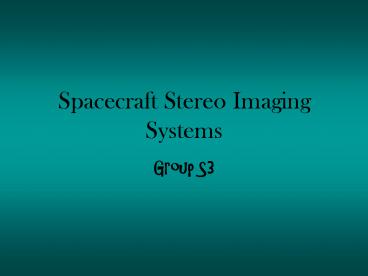Spacecraft Stereo Imaging Systems - PowerPoint PPT Presentation
1 / 17
Title:
Spacecraft Stereo Imaging Systems
Description:
Height of the cameras relative to the bench. Angle The direction cameras are facing relative to each other ... Initial Attempts at a Stereogram. Calibration ... – PowerPoint PPT presentation
Number of Views:34
Avg rating:3.0/5.0
Title: Spacecraft Stereo Imaging Systems
1
Spacecraft Stereo Imaging Systems
- Group S3
2
Variables
- Separation of the cameras
- Height of the cameras relative to the bench
- Angle The direction cameras are facing relative
to each other
3
Other Considerations
- Distance Between the object and the cameras.
- Size of the object
4
Theory of stereo images
f focal length of the cameras.
and
are the points in the two images, produced by the
cameras.
5
Theory of stereo images
By considering the geometry of the system we can
obtain a set of 3 simultaneous equations
These equations can be rearranged to find
equations for the coordinates of the object - x,
y and z.
6
Theory of stereo images
7
Theory of stereo images
The quantity , which appears in all the
equations is known as disparity.
8
Stereo Views
Left Camera
Right Camera
The objects are displaced in one image relative
to the other. These displacements are known as
DISPARITIES.
9
Producing Stereograms
- The optimal ratio of object distance to camera
separation is 30/1. - Separation of the camera the same as average
human eyes. - Displacement of objects inversely proportional to
the distance
10
Initial Attempts at a Stereogram
11
(No Transcript)
12
Calibration
- The demagnification of the camera was found at a
range of distances. - This was done using a single camera.
13
Calibration
- where h is the height of the object h is the
image height, s is the object distance and s is
the image distance.
The image height h is given by
where n is the number of pixels and w is the
width of 1 pixel (a single sensor) inside the
camera.
14
Calibration
By plotting a graph of the height in pixels, n,
versus the distance s, for an object of known
height, the constant s/w can be found from the
gradient, m.
15
Calibration Graph
16
Determination of Object Height and Range
Now the ratio h/s can be found by measuring the
image height in pixels but more information is
needed to distinguish between a small object
which is close and a large object which is far
away.
17
Finally
We took some measurements of position in each of
the two images and used them to find the x
position of the object. We will continue this in
the next lab session.































